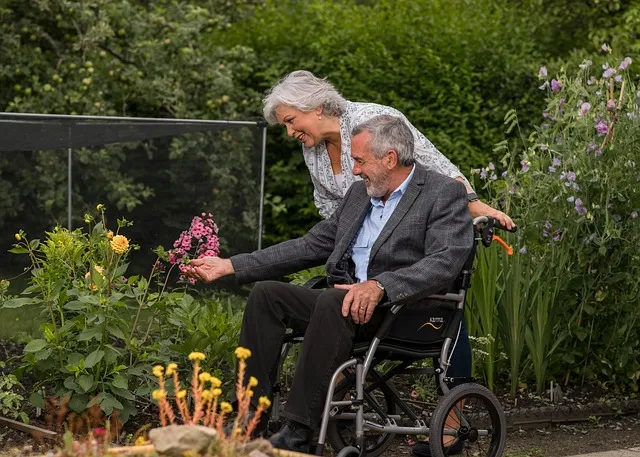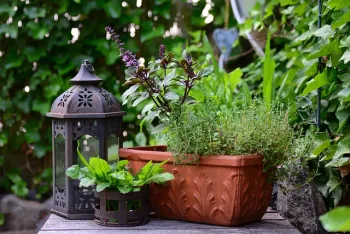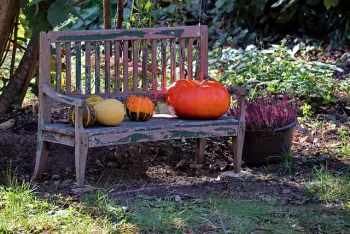Article by Mike Kluk -
I recently passed one of those yearly milestones that has left me looking down the road of my seventy-fourth year. I’m hoping to remain active, healthy, and happy next year and for many more. As we age, many of us begin to realize that living better is equally important with living longer. We can't turn back time, but we can cultivate activities that support our health and interests well into our later years. For me, one of the most rewarding ways to do this is through gardening that focuses on practices that promote a healthy lifestyle with the knowledge and flexibility to accommodate a body that is going to inevitably change. If you are relatively young and thinking this doesn’t apply to you. . . yes it does. Adopting thoughtful gardening practices at any age will always pay benefits now and in the future.
The connection between gardening and health is not anecdotal. Research consistently shows that gardening provides moderate physical exercise, reduces stress, improves mental health and, if you choose to grow a few fruits and vegetables, can supply nutrient-dense foods that support health. By selecting the right plants and adopting sustainable practices, we can create gardens that nurture both our bodies and our spirits for decades to come.
Design

A garden designed with the long-term in mind should consider how your mobility and energy levels might change over time. Choose garden locations that will remain accessible as you age. Avoid steep slopes or areas that require navigating steps or uneven terrain. Morning sun exposure is ideal for most edible plants, and having the garden close and visible from your kitchen window can make it easier to monitor and enjoy.
Consider installing wide pathways (at least thirty-six inches) that can accommodate mobility aids if needed. Compacted road-base gravel or permeable pavers are easier to navigate than bark chips or irregular stone.
Raised beds, at least twenty-four inches high, help reduce bending and strain. Note that you do not need to build such high beds if mobility and bending are not issues for you currently. Beds that are just six inches high will save materials and cost. They will define your growing areas and pathways and our native soil under a bed is perfectly able to support healthy plants. The height of those shorter beds can be increased, as necessary. Eventually, you may want to move to waist-high beds or large containers that can be tended from a seated position. Half whiskey or poly barrels work well for this purpose and can accommodate a surprising variety of plants. To Raise or Not to Raise – That is the Question is an article that covers raised beds in more depth.
Heavy mulching around plants reduces weeding and watering needs. Consider drip irrigation or soaker hoses to minimize the physical demands of watering. Group plants with similar water needs together to make care more efficient.

While annual vegetables and ornamentals are rewarding, incorporating more perennial plants in your garden design reduces yearly replanting work. Asparagus, artichokes, rhubarb, berries, fruit trees and perennial herbs like sage, oregano, rosemary, thyme and perennial landscape plants are valuable investments in future years of gardening.
Adaptive Tools Can Be a Real Benefit
As we age, it is important to work smarter, not harder. Invest in ergonomic tools to reduce strain. There is a wide range of adaptive tools available with modified handles to reduce bending and uncomfortable hand positions. For those with grip issues, foam-handled pruners and other tools ease hand fatigue. Use a garden cart instead of heavy wheelbarrows. A low, lightweight seat can make reaching the soil much more comfortable. By choosing tools that fit your body, you’ll garden comfortably for decades. Adaptive Gardening: How to Adapt Gardening to “Challenged” Bodies is an article that discusses adaptive tools.
Soil Health Promotes Your Health
Healthy soil is the foundation of a sustainable life-long garden. Invest time early in building soil with plenty of organic matter. Compost, aged manure, and leaf mold will create soil that retains moisture, drains well, and supports beneficial microorganisms. Healthy soil has been shown to grow more nutritious food. For more information, see the University of Washington’s article - Farms following soil-friendly practices grow healthier food, study suggests.
Test your soil pH annually and amend as needed for optimal nutrient uptake. Most vegetables prefer slightly acidic to neutral soil (pH 6.0 to 7.0). A soil test will also reveal any deficiencies in essential nutrients. Our neutral or slightly basic native soil is generally good for many ornamentals.
Seasonal Eating and Preservation
Plan your garden to provide fresh, healthy food throughout the year. Cool-season crops like broccoli, cabbage, kale, and peas can extend your harvest into winter and early spring. In our climate, you can eat fresh vegetables all year round. If you want, employ simple preservation techniques like freezing, canning, dehydrating, or fermenting to enjoy your garden's bounty year-round.
Consider succession planting - sowing small amounts of fast-growing crops like lettuce and radishes every few weeks to ensure continuous harvests rather than feast and famine cycles. Many annual flowers are well adapted to our cool, wet winters. Having vegetables and flowers growing in the garden through winter helps to keep you active and avoid the winter blahs.
Good Mental Health is the Root of Good Physical Health

Don't underestimate the psychological benefits of gardening. The act of nurturing plants, watching them grow, harvesting your own food and appreciating the pollinators, birds, and other critters that may also depend on your garden, provides an important sense of purpose, accomplishment, and wonder that becomes increasingly important as we age.
Gardening can also help you stay connected with your community. Gardeners love to talk gardening with other gardeners. There are an unending number of topics, problems to solve, and successes to share. And, of course, fresh vegetables and fruits to distribute to friends and neighbors will make you a popular guest.
Plan for quiet spaces in your garden where you can sit and reflect. A simple bench among fragrant herbs or flowering plants can provide a peaceful retreat that supports mental well-being.
Start Small
If you're new to gardening, start with a small, raised bed or several large containers. Focus on a few easy-to-grow, nutrient-dense plants like lettuce, herbs, cherry tomatoes, kale, and Swiss chard. Add some easy-to-grow flowers like zinnias, asters, catmint, yarrow, and, in the winter, calendulas and pansies. As you gain confidence and experience, you can expand your garden and experiment with more challenging plants.
Growing a garden for life is ultimately about creating a sustainable system that supports your health and happiness now and in the future. By choosing the right plants, designing for accessibility, and building healthy soil, you are investing in a future where fresh, nutritious food, beautiful and interesting flowers, and the joy of gardening can continue to enrich your life. Your future self will thank you for the thoughtful planning and the years of healthy activity, homegrown food, and beautiful bouquets that follow.
Additional References
M. Soga, K.J. Gaston, Y. Yamaura (2017) Gardening is beneficial for Health: A meta-analysis, ScienceDirect.
UC ANR - Adaptable Gardening - How to Make Your Garden Fit for You!
Images by karmamarketing, congerdesign, and Michael Hüttl from Pixabay.
